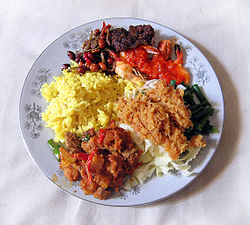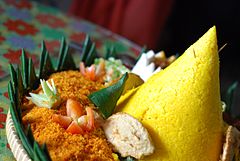 Nasi kuning personal serving, surrounded with rich Indonesian dishes | |
| Alternative names | Nasi kunyit, Pulut kuning |
|---|---|
| Course | Main course |
| Place of origin | Indonesia[1] |
| Region or state | Java |
| Associated cuisine | Indonesia, also found in Malaysia, Singapore, the Netherlands, the Philippines, Suriname, Sri Lanka (known as kaha buth) and South Africa |
| Serving temperature | Hot and room temperature |
| Main ingredients | Rice cooked in turmeric surrounded with side dishes |
| Similar dishes | Hsi htamin |

Nasi kuning (Indonesian for: "yellow rice"),[2] or sometimes called nasi kunyit (Indonesian for: "turmeric rice"), is an Indonesian fragrant rice dish cooked with coconut milk and turmeric,[3][4] hence the name nasi kuning (yellow rice).[1]
In the Philippines, a related dish exists in Mindanao, particularly among the Maranao people, where it is known as kuning. Like the Indonesian version, it primarily uses turmeric, but also adds lemongrass and does not use coconut milk.[5][6] A similar dish is also found in Sri Lankan cuisine where it is known as kaha buth (and Lamprais) and draws from both Indonesian and Sri Lankan influences.[7][8]
Cultural significance[edit]
In Indonesian culture, nasi kuning has favourable symbolic meanings. The yellow-coloured rice is perceived to look like a pile of gold,[9] so it is often served on festive occasions; including parties, housewarmings, welcoming guests, and opening ceremonies – as a symbol of good fortune, prosperity, wealth, and dignity.[10]
Nasi kuning is quite widespread and commonly found in Indonesian culture. It can be found from Java to Sumatra, Bali, and Sulawesi. However, it is most strongly associated with Javanese and Minahasa traditions. In Java, nasi kuning might come in the form of a cone called a tumpeng and is usually eaten during special events.[11] The top of the tumpeng is customarily given to the most senior person in attendance. One of the most popular nasi kuning variants comes from Manado in North Sulawesi, which employs cakalang (skipjack tuna).[12]
Ingredients and serving[edit]
The addition of turmeric and coconut milk, sometimes also including pandan and lemongrass during the rice cooking and steaming process, has contributed to a tempting colour, pleasant fragrance, soft texture, and a flavourful taste of the yellow rice. Certain spices such as cinnamon, cardamom, cloves, and bay leaves, might be added to enhance this aromatic fragrant rice dish.[13]
Nasi kuning is usually served with a variety of side dishes such as shredded omelette, serundeng (relish of grated coconut and spices), urap (vegetable in shredded coconut dressing), teri kacang (fried anchovy and peanuts), sambal goreng (fried tempeh and potato caramelised in spicy sauce), ayam goreng (Javanese-style fried chicken), balado udang (shrimp in chilli), or perkedel (potato fritters).[14] More complex nasi kuning could consist of fried cow's brain, fried cow's lung, beef, and seafood. It is common to serve nasi kuning with kerupuk udang (shrimp cracker) or emping chips and a decoratively cut cucumber and tomato.
Varieties[edit]
There are various types of nasi kuning throughout Indonesia with typical various side dishes in each region.[15]
By regions[edit]
- Nasi kuning Ambon – with spicy skipjack tuna, spicy boiled egg, and stir-fried cellophane noodles.
- Nasi kuning Banjar – with masak habang side dish including ikan haruan (Snakehead murrel).
- Nasi kuning Gorontalo – with chicken broth soup.
- Nasi kuning Jawa – with orek tempe, perkedel, shredded omelette, and ayam goreng.
- Nasi kuning Makassar – with sayur labu siam (chayote soup).[16]
- Nasi kuning Manado – with shredded skipjack tuna wrapped in woka (Saribus rotundifolius) leaf.
Gallery[edit]
-
Nasi kuning Banjar
-
Preparing nasi kuning Manado in a woka leaf
See also[edit]
- List of rice dishes
- Java rice
- Kuning
- Nasi bogana
- Nasi campur
- Nasi goreng
- Nasi kucing
- Nasi lemak
- Nasi liwet
- Nasi pecel
- Nasi tim
- Nasi uduk
- Nasi ulam
- Sinigapuna
References[edit]
- ^ a b Salloum, Habeeb (14 December 2003). "Recipe: Nasi Kuning – Indonesian Yellow Rice | ThingsAsian". thingsasian.com. Retrieved 24 January 2018.
- ^ Holzen, Heinz Von (15 September 2014). A New Approach to Indonesian Cooking. Marshall Cavendish International Asia Pte Ltd. p. 51. ISBN 9789814634953.
- ^ Agostino, Helen; Kiting, Kathy (1999). Indonesia Kaleidoscope. Curriculum Corporation. ISBN 9781863663830.
- ^ Holzen, Heinz Von; Arsana, Lother (1999). The Food of Indonesia: Authentic Recipes from the Spice Islands. Periplus Editions. ISBN 9789625933894.
- ^ Balistoy, Ruby Leonora R. "Pagana Maranao—fostering culture of peace". Philippine Information Agency. Retrieved 5 March 2019.
- ^ Abdulwahab, Nabeelah T. "The Beauty, Warmth, and Hospitality of Pagana". Intangible Cultural Heritage Courier of Asia and the Pacific. International Information and Networking Centre for Intangible Cultural Heritage in the Asia-Pacific Region (ICHCAP). Retrieved 5 March 2019.
- ^ "Malay Dishes". YoungMelayu Sri Lanka.
- ^ Bullis, Douglas; Hutton, Wendy (2001). Food of Sri Lanka. Periplus. pp. 5, 14. ISBN 9625937609.
- ^ Roepers, Cyrus (22 October 2014). "Nasi Kuning: Indonesian Festive Rice". Arousing Appetites: Home to the Serious Cook. Retrieved 25 January 2018.
- ^ "Nasi Kuning Recipe (Indonesian Yellow Fragrant Rice)". Indonesia Eats.
- ^ Turner, T. (27 October 2015). Bali Travel Guide 2018: Must-see attractions, wonderful hotels, excellent restaurants, valuable tips and so much more!. T Turner.
- ^ Maya Safira (26 April 2016). "Nasi Kuning Manado yang Sedap dengan Pelengkap Ikan Cakalang". detikFood (in Indonesian).
- ^ "Nasi kuning (yellow rice)". taste.com.au. 26 July 2010. Retrieved 25 January 2018.
- ^ "Menyiapkan Lauk Tumpeng". detikfood (in Indonesian). Retrieved 25 January 2018.
- ^ Afrillia, Dian. "Mengenali Perbedaan Nasi Kuning dari Berbagai Daerah di Indonesia". goodnewsfromindonesia.id (in Indonesian). Retrieved 17 April 2024.
- ^ Lobubun, Darul Amri; Irham, Muh. "Lima Nasi Kuning di Makassar yang Enak, Salah Satunya Langganan Mantan Presiden RI". tribunnews.com (in Indonesian). Retrieved 17 April 2024.

